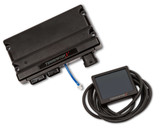Setting up a Turbocharged Engine
Why do turbo engines have low compression ratios? Why does altitude have less effect on a turbo motor than a naturally aspirated one? What fuel should you use? Here’s what you need to know if you’re thinking about turbocharging your Mustang or upgrading the turbo on your Ecoboost.
Boost Compression Ratio
The same rules of thumb for compression ratio on a naturally aspirated engine
can be applied to a turbocharged engine if boost is considered. This formula
provides the boost compression ratio, which is the total pressure resulting
from added boost pressure:
[(Maximum Boost Pressure / Atmospheric Pressure) + 1] x Compression Ratio
Lowering compression lets you safely run more boost pressure, but the effect of
atmospheric pressure depends on altitude.
Altitude and Atmospheric Pressure
Air pressure is 14.7 PSI at sea level, 12.1 PSI at Denver, the “Mile High
City,” and just 8.6 PSI on the Mount Evans Scenic Byway, the highest paved road
in the U.S. Increasing boost pressure can help maintain absolute (total)
pressure as atmospheric pressure drops, but the added pumping will heat the
intake charge. Using a larger intercooler can help compensate for this heat.
Controlling Boost
The wastegate controls boost by using an actuator connected to the intake and
exhaust turbine housings. This actuator is held shut by a spring. Once intake
pressure reaches a specific point, it overcomes the spring pressure and opens a
valve that lets some of the gases out of the exhaust housing, lowering the
amount of force on the turbine.
A boost controller taps into the intake side of the actuator, bleeding off some
of the air. That means more boost is needed to compensate and open the
actuator. The Ecoboost’s controller adds boost as RPM increases, but you can
set up a controller any way you want for your needs, and even have separate
tunes for street and race conditions.
Detonation and Pre-Ignition
When fuel is ignited, it creates a flame front and a shock wave. Ideally, these
forces move together with cylinder pressure reaching its peak between 17 and 20
degrees after Top Dead Center. If the flame front and shock wave are out of
sync, they’ll meet inside the combustion chamber, causing detonation.
Pre-ignition is caused by ignition of the fuel air mixture before the spark plug
fires. This can be traced to hot spots inside the cylinder. Either way, there
will be a knocking sound and possible damage to internal components
To stop detonation from happening, the boost compression ratio needs to be
lowered, either by lowering boost pressure or using a lower compression ratio.
To stop pre-ignition from happening, the ignition needs to be retarded so that
the fuel is ignited by the spark plug instead of the hot spots, or the cylinder
temperatures need to be lowered by adding more fuel or lowering the boost
compression ratio.
Fuel Choice
The faster a fuel burns, the less likely the flame front and shock wave will be
out of sync, reducing detonation. This is expressed through the Octane rating,
based around the burn rates of n-heptane (0) and iso-octane (100.) Switching
from regular 87 Octane fuel to 91 or 93 Premium gives you more room for boost
without detonation. The Ecoboost can compensate for this automatically, which
is why it produces more power on premium fuel than it does on regular.
Liquid fuel is denser than air, letting it absorb more heat, so more fuel means
lower combustion temperatures. Ethanol is less energy dense than gasoline,
requiring richer fuel/air mixtures that cool the cylinder. This allows higher
compression and more advanced timing, increasing power before pre-ignition
occurs. E85 also has an Octane rating of 105, helping further curb detonation.
Unfortunately, fuel labeled “E85” can be anywhere between 51 and 83%, which
means a single tuning setup won’t always work with this fuel. To compensate for
this, flex fuel ECUs measure the ethanol content and adjust the boost and fuel
maps accordingly. With ethanol-based race gas, the ethanol content is always
known, so the engine can be set for a specific fuel mixture.
There’s also water/methanol injection. Like ethanol, methanol is high octane
and can absorb a lot of heat, letting the engine handle more boost. However, it
can simply be added to the intake alongside gasoline instead of doing a full
fuel conversion, making it a cheap option for squeezing more power out of your
engine.
Add Boost to Your Build with Help from
Anderson Ford Motorsport
Anderson Ford Motorsport has been tuning, racing and selling parts
for Mustangs from
the start of the Fox body era. Using that experience, we’ve developed kits to
add a turbo to a naturally aspirated V8 or get more power from an Ecoboost
engine. Going the DIY route? We have everything you need including methanol
injection systems, heads, camshafts and even crate engines built to withstand
forced induction.
Recent Posts
-
Bringing the Fox Body Mustang into the 21st Century with Holley Terminator X
Anderson Ford Motorsport has been in the Fox Mustang performance industry since 1989. One of the bi …22nd Oct 2021 -
Roush Supercharger install on a 2019 Ford Mustang
Check out this 2019 Ford Mustang before and after we installed a Roush Supercharger.21st Feb 2020 -
All Blower Installations are not Equal.
Why Should You Choose a Company to Install Your Blower That Has a Dyno Facility In-House?Are all de …24th Jan 2020

